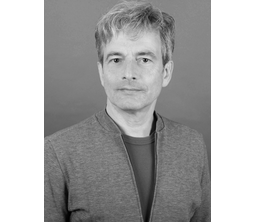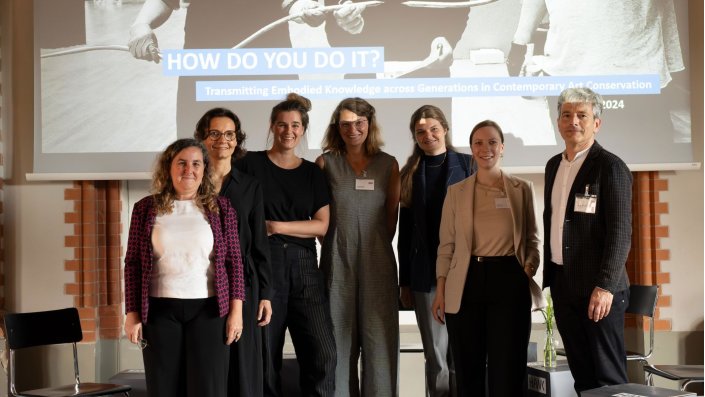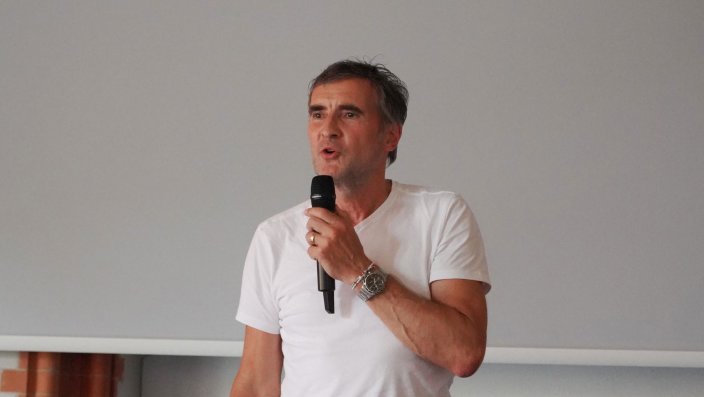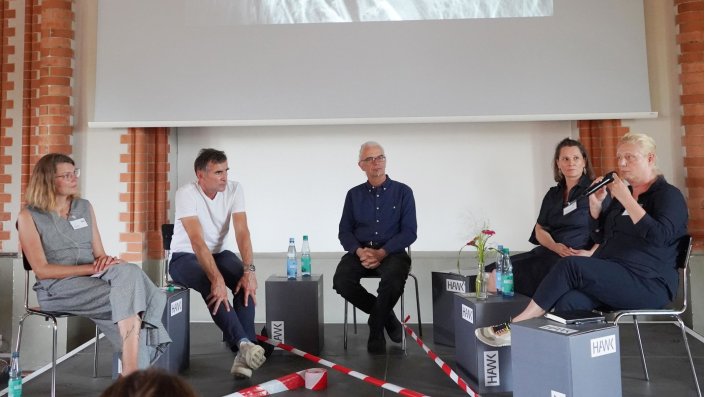Legacies of Artists’ Studios (LAS)
The international research project “Legacies of Artists’ Studios: Sharing and archiving embodied knowledge for the conservation of technology-based artworks”, funded by the Wüstenrot Stiftung, aims to develop strategies for accessing, transmitting, and archiving practical know-how and hand skills from artists’ studios to facilitate future re-installations of complex technology-based artworks.
Informal records found in artists’ studios, such as sketches, doodles, quick notes scribbled on scrap paper, or spare materials—often collectively referred to as ‘ephemera’—are receiving increasing consideration in the preservation of contemporary works of art. However, preserving an artwork involves more than just considering the physical artifacts used and left behind by artists and their assistants during the creative process. Equally important are the particular hand skills and tacit knowledge that each participant gains through their involvement in artistic production. This type of knowledge becomes ‘embodied’ in their practices and behaviours. The research project assumes that this form of implicit, embodied knowledge—held unconsciously within the body—can be highly valuable, and sometimes even essential, for the documentation, interpretation, preservation, and eventual reinstallation of complex works of art.
The urgency of addressing this area of investigation is undeniable as the era of technology-based art has already spanned across the past five decades, and many of its pioneers have passed away. The rapid evolution of technological equipment—both hardware and software—and the increasing challenges in operating obsolete devices further complicate the preservation of technology-based artworks.
The research project started in 2024 with the symposium “How Do You Do It? Transmitting Embodied Knowledge across Generations in Contemporary Art Conservation” in Hildesheim, where the topic of embodied knowledge was discussed with international experts. Embodied knowledge refers to the tacit understanding inherent in the body, allowing individuals to perform and refine tasks without consciously considering each step involved in these actions. In the context of complex artworks, which often incorporate technology-based or performative components, this tacit or embodied knowledge is anchored in the artist’s vision, developed and fine-tuned throughout their career and transferred often implicitly to their assistants through years of collaboration. Custom-made devices, unique installation techniques, and aesthetic preferences define such works of art. However, these individualised tweaks that make the artwork come to life tend to happen on the fly and often implicitly, thereby defying or evading traditional forms of documentation.
The research project “Legacies of Artists’ Studios” raises the following questions:
- Which knowledge gaps can be identified in research and conservation’s common documentation strategies during an installation of a complex artwork?
- What different types of knowledge are located inside an artist studio, and how can they be effectively transmitted and preserved?
- What strategies are necessary to access implicit or embodied knowledge?
- How can we observe and analyse the ways in which individual artists communicate their artistic intentions to their assistants?
- How can we observe and analyse the strategies artists use to share knowledge, as well as to archive and document their work within the studio?
We have come to realize that embodied knowledge can constitute an essential component to document, interpret, preserve and re-install especially, but not only, artworks from bygone technological eras. In many cases, this knowledge is not only held by the artist but may be found in close collaborators such as long-time assistants, fabricators, and technicians of that time. It may be reflected in the naturally grown artists’ studio practices as well as in their archiving habits of self-documentation. But because it is so essential, so internal to the artists’ mind and by extension their creative environment, it is often unspoken and hence not explicitly part of any efforts of self-documentation.
The “Legacies of Artists’ Studios” research project seeks to connect artists’ studios, artists’ estates, museums, archives, universities and individual experts such as artists’ assistants, fabricators, technicians, and conservators to share knowledge and develop best practices that support the preservation and presentation of technology-based artworks.
State of the Art
Since the 1990s, museums have begun to acquire and preserve technology-based artworks and installations. However, since these works were initially “misread” through the lens of traditional forms of art, the strategies for their documentation and conservation proved to be highly insufficient. Museums and other collecting institutions often focused on acquiring the core components of these complex artworks, overlooking ancillary materials and ephemera such as sketches, plans, scores, video masters, spare devices or replacement parts. In particular, the necessary hand skills and technical know-how (the ‘embodied knowledge’) required to maintain and install these artworks in line with the artist’s intentions were often overlooked.
Many artworks were acquired before an effective workflow for the acquisition of technology-based artworks had been established, which means that the necessary specifications and know-how for their assembly and presentation are often missing. However, technology-based artworks can only be experienced when they are properly installed and functioning. Without the necessary knowledge, these works cannot be displayed or may lack the necessary 'fine-tuning' resulting in an appearing as life-less shells of their essence. Most literature on the conservation of technology-based artworks deals with the challenges of outdated technology. Nevertheless, the research focus has predominantly been on the obsolescence of equipment and spare parts, while the role of embodied knowledge has been addressed only sporadically. Yet, the human aspect of obsolescence and the importance of expertise held by individuals skilled in specific technologies and tasks are crucial for the conservation of these artworks.
Conversely, many artists are unaware of the value of their internally accumulated knowledge, habits, and procedures that are essential for realising the full potential of their artworks during future (re-)installations. Over the course of the artists’ creative career, their assistants and involved fabricators have implicitly learned to imbue the artist’s intention into those artworks. Moreover, they may possess know-how about technologies and performative aspects concerning the works that may disappear if they are not (explicitly) looked for and transmitted towards future generations.
While it is widely recognized that artists’ estates play a crucial role in ensuring that artworks are preserved and passed on to future generations, there has been little attention given to the challenge of also preserving the procedural and embodied knowledge essential for understanding, maintaining and reinstalling the works in the future.
Project Goals
The overall goals of the research project are to:
- explore the scope and significance of embodied knowledge in the approach to (time-based media) technology-based art conservation;
- raise awareness about different facets and sources of knowledge, and identify key ‘knowledge holders’ essential for safeguarding technology-based artworks in the future;
- explore needs, challenges, possibilities, and best practices for researching, documenting and transmitting relevant knowledge from artists’ studios to ensure the preservation of art works;
- investigate the role and authority of the artist's assistant over time and across different relational dynamics.
In order to reach these goals, LAS identified various core areas in which implicit knowledge and its transmission are crucial and which will be explored through various case studies. The core research areas are:
1. Mapping knowledge sources and enhancing transfer in re-installing technologically obsolete artworks;
2. Observing archiving strategies of artists’ studios;
3. Transferring expertise of artists’ assistants;
4. Handing over works from an artist’s studio to an institution.
Core Research Areas and Case Studies
The project goals are achieved through case studies structured into the four research areas. While the first research area allows for the exploration of a vast array of knowledge sources and their transfer to future generations, the other research areas focus on particular nodes of knowledge transfer. Their goal is to identify potential gaps in the transmission of know-how that proves to be crucial for enabling future re-installations.
1. Mapping Knowledge Sources and Enhancing Transfer in Re-installing Technologically Obsolete Artworks
The first research area addresses the common scenario of re-installing an artwork from a past technological era by its current owner. This area is explored through a case study involving the interactive installation Dove va tutta ‘sta gente? (Wohin gehen all diese Leute?) by Studio Azzurro. The work, which is one of the most important “ambienti sensibili” (sensitive environments) of the artistic collective Studio Azzurro, was first realized in 2000 for the exhibition vision.ruhr in the Zeche Zollern in Dortmund and entered the collection of the Museum Ostwall the same year. Since 2021, it has not been presented in its most complete form again.
The case study will make it possible to present Dove va tutta ‘sta gente? anew to the public through a test installation. Moreover, it seeks to demonstrate how records, materials, and expertise from artists’ studios as well as from their former media assistants can be transmitted, recovered and used to preserve their work within a museum context. To this purpose, different modes of knowledge transmission will be explored, with the goal of assessing their advantages, disadvantages, and effectiveness in capturing and conveying relevant knowledge.
2. Observing Archiving Strategies of Artists’ Studios
The second research area focuses on the artist’s studio, where artworks are creatively conceived and produced. Many artists and their studios have developed organically grown structures for organizing and collecting information and materials, and have built networks of involved assistants and external experts to realize their visions.
We aim to study current practices in artists’ studios to gain insights into their methods and ways of documenting and transmitting relevant (embodied) knowledge. Our goal is to develop a support system for artists’ studios that assists them in archiving records, sharing knowledge about their technology-based works and reflectively self-documenting their processes. This could help prevent gaps in information that may jeopardize the preservation of their artworks in the future. The flow of knowledge transmission, both within and beyond artists’ studios, is central to this investigation.
A case study of this research area will involve the studio of the artist Mischa Kuball. The studio is on the process of documenting the already completed work missing link, realised in Düsseldorf in 2024. More than 40 people were involved in this project. The observed archival and transmission strategies will be detailed in a review, and possible gaps in the documentation process will be addressed.
Another case study will involve the Moontower Foundation in Bad König, Odenwald, founded by the artist Rebecca Horn, who died in 2024. Field research will be conducted to observe the transition of this foundation from an actively operating artist's studio to an artist's estate that focuses on archiving and re-installing.
3. Transferring Expertise of Artists’ Assistants
The role and expertise of long-term artist assistants is increasingly recognized in the conservation and preservation of modern and contemporary artworks, particularly of those with technological components. Artists often rely on their assistants or external fabricators who have developed and fine-tuned specific skills in operating technological components and handling media equipment – skills that artists themselves may not possess. This expertise, especially in long-term relationships between artists and their assistants, is influenced by the artist’s vision, which may or may not have been explicitly communicated. The assistant’s manual skills support, and sometimes even enable, the visual language of the artist. Furthermore, assistants tend to be of younger age than the artists. Realistically and practically, this means assistants are often available for a couple of decades beyond the artist’s presence.
A case study will exemplarily enable the transmission of embodied knowledge from an artist’s assistant to a conservator.
4. Handing over works from an Artist’s Studio to an Institution
Transferring a selection of artworks and its supporting data from an artist’s studio to an external archive is probably the stage at which most information is lost. This is where the artist’s work is filtered through external criteria that may overlook the importance of embodied knowledge and technical sketches.
A case study will examine the transfer of knowledge from an artist's studio to the Künstler:innenarchiv of the Stiftung Kunstfonds in Pulheim-Brauweiler, near Cologne. It includes the aspect of knowledge transfer to future generations, also taking into account the education and training of conservators.
Project partners
- Cologne Institute of Conservation Sciences, TH Köln, Prof. Dr. Gunnar Heydenreich, Juliana Maier
- HAWK Hochschule für Angewandte Wissenschaft und Kunst, Hildesheim, Prof. Dr. Tiziana Caianiello, Sandy Bruer
- Museum Ostwall im Dortmunder U, Regina Selter, Nicole Grothe, Lisa Schiller
- Wüstenrot Stiftung, Ludwigsburg
- Università Vita-Salute San Raffaele, Mailand, Prof. Dr. Francesca Pola
- Künstler:innenarchiv der Stiftung Kunstfonds, Puhlheim, Anna Wondrak
- Freelance conservators: Julia Giebeler (Köln, Cologne), Mareike Opeña (New York)
Galerie
 0 / 0
0 / 0
The international research project “Legacies of Artists’ Studios: Sharing and archiving embodied knowledge for the conservation of technology-based artworks” aims to develop strategies for accessing, transmitting, and archiving practical know-how and hand skills from artists’ studios. (Bild: Eva Rieß, Hamburger Bahnhof – Nationalgalerie der Gegenwart, Berlin)






